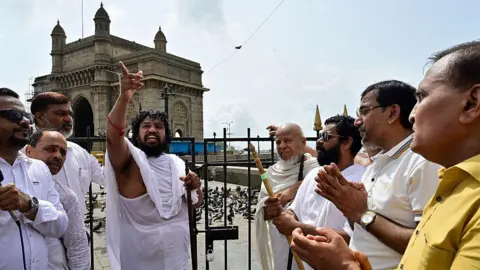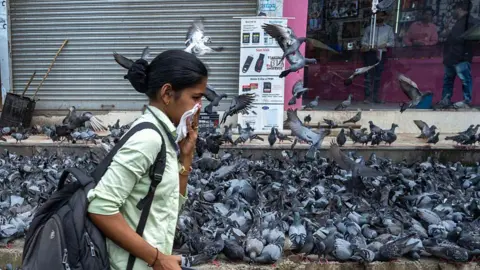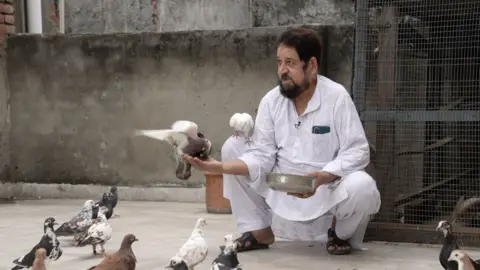 NurPhoto via Getty Images
NurPhoto via Getty ImagesA recent court ban on feeding pigeons in public spaces in the western Indian city of Mumbai has become a major flashpoint between civic bodies, public health activists and bird lovers.
This month, hundreds of people clashed with police twice while protesting the closure of a decades-old pigeon feeding spot, or a kabutarkhana. (Kabutar is the Hindi word for pigeon.)
Some tore down the tarpaulin sheets covering the spot and threatened an indefinite hunger strike. Police briefly detained about 15 people at another protest, media reports said.
Authorities had imposed the ban due to concerns about health hazards due to pigeon droppings.
The problem is not unique to Mumbai. In Venice, feeding pigeons in historic squares is banned. Singapore imposes hefty fines, and New York and London have regulated feeding zones.
In India too, Pune and Thane cities in Maharashtra state – of which Mumbai is the capital – have imposed penalties on feeding pigeons. Delhi is mulling an advisory against feeding the birds in public spaces.
The crackdown has angered animal lovers and religious feeders, as pigeons are long woven into India’s cultural fabric.
Films often use shots of grain-feeding pigeons to evoke cities like Mumbai and Delhi, where the birds are a familiar presence on balconies and air-conditioners.
 Hindustan Times via Getty Images
Hindustan Times via Getty ImagesSome of Mumbai’s kabutarkhanas are iconic heritage structures and are said to have originated as charitable spaces where communities could donate grain.
There are religious sentiments involved as well. In Mumbai, the Jain community, which considers feeding pigeons a pious duty, has been vocal in their protests.
Elsewhere too, many share a bond with pigeons – seen as symbols of peace and loyalty .
In Delhi, Syed Ismat says he has been feeding the birds for 40 years and considers them his family.
“They are innocent. Perhaps the most innocent of all creatures. All they ask for is a little kindness,” said Mr Ismat.
But these sentiments are pitted against studies which show that prolonged exposure to pigeon droppings poses risks of pulmonary and respiratory illnesses.
A boom in India’s pigeon population in recent years has heightened this risk, prompting the restrictions.
Delhi-based biodiversity expert Faiyaz Khudsar says easy availability of food has led to overpopulation of pigeons in many countries.
In India, he said, the challenge is compounded by a decline in birds like the goraiya, commonly known as the house sparrow, which are increasingly being displaced by pigeons.
“With easy food and no predators, pigeons are breeding faster than ever. They are outcompeting other urban birds, creating an ecological loss,” Mr Khudsar said.
 Hindustan Times via Getty Images
Hindustan Times via Getty ImagesThe 2023 State of India’s Birds report says pigeon numbers have risen more than150% since 2000 – the biggest jump among all birds – leaving homes and public spaces with droppings, as each bird can produce up to 15kg (33lbs) a year.
Studies show these droppings contain at least seven types of zoonotic pathogens that can cause diseases such as pneumonia, fungal infections and even lung damage in humans.
Nirmal Kohli, a 75-year-old Delhi resident, started complaining of persistent cough and had trouble breathing a few years ago.
“Eventually, a CT scan showed that part of her lung had shrunk,” says her son Amit Kohli. “The doctors said it was due to exposure to pigeon droppings.”
Last year, an 11-year-old boy died in Delhi due to hypersensitivity pneumonitis – a disease that causes inflammation in lungs. Doctors said the reason was prolonged exposure to pigeon droppings and feathers.
RS Pal, a pulmonologist, told the BBC that such cases were common.
“Even if you don’t directly feed pigeons, their droppings on window sills and balconies can cause hypersensitivity pneumonitis,” he said.
“We also see bacterial, viral and fungal infections in people handling pigeons regularly.”
These concerns are what led the Mumbai civic body to impose the feeding ban last month and launch a drive to demolish feeding centres.
 Anshul Verma/BBC
Anshul Verma/BBCDemolitions are on hold, but the Bombay High Court has dismissed a plea against the feeding ban, citing public health as “paramount” and ordering strict action on illegal feeding.
Delhi mayor Raja Iqbal Singh told the BBC that love for birds cannot come at the cost of people’s well-being.
“Feeding spots often turn dirty, leading to foul smells, infections and pests. We are working to minimise feeding,” he said.
But many animal lovers disagree.
Mohammad Younus, who supplies grains to a feeding spot in Delhi, argues that all animals can spread diseases if hygiene is not maintained.
“I have been surrounded by pigeons for the past 15 years. If something were to happen, it would have happened to me too,” he said.
In Mumbai, a Jain monk told BBC Marathi that thousands of pigeons would die of hunger due to the feeding ban.
Megha Uniyal, an animal rights activist, pointed out that there was no clarity on how the ban on feeding pigeons would be implemented.
“As far as regulating pigeon feeding is concerned, it is a word thrown around by the authorities, but no one really understands what this could entail,” she said.
Amid these competing contentions, efforts are on to find a middle ground.
Ujjwal Agrain, of People for the Ethical Treatment of Animals (Peta) India, suggests allowing pigeon feeding only during set morning and evening hours.
“That gives enough time for civic bodies to clean the place and maintain hygiene. This way, we respect both public health and emotional bonds,” he said.
The Bombay High Court has set up an expert panel to suggest alternatives, and Mumbai civic officials say controlled, staggered feeding may be allowed based on its advice.
For Syed Ismat, the solution lies in rethinking the relationship between birds and urban spaces.
“Maybe it’s time to reimagine how we share our cities, not just with pigeons but with all forms of life,” he said.
Additional reporting by Sharanya Dayal in Delhi
Follow BBC News India on Instagram, YouTube, Twitter and Facebook



